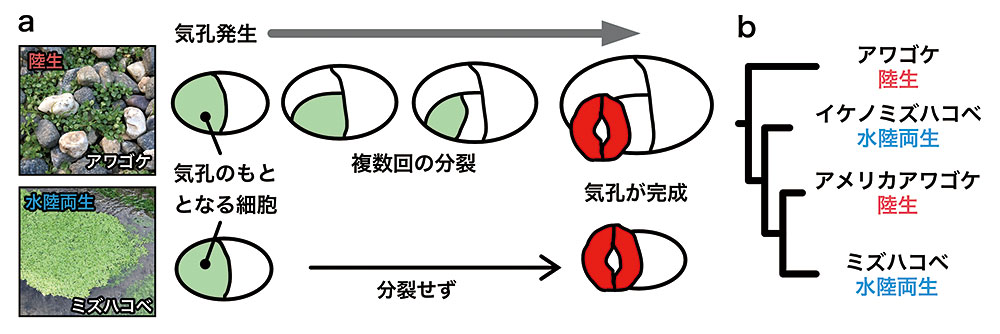Disclaimer: machine translated by DeepL which may contain errors.
Stomatal Formation in Plants Changes with Life
Yusei Dollar( Department of Biological Sciences, 1st Year Doctoral Student *) |
Teruyuki Koga( Assistant Professor, Department of Biological Sciences) |
Yuichi Tsukatani( Professor, Department of Biological Sciences) |
| * Grade at the time of research |
The genus "Astragalus" is not a moss family, but a flowering angiosperm. The genus "Astragalus" includes species that have adapted to a variety of environments. The mosses Astragalus and Astragalus americanus are terrestrial species that grow on the ground in fields and under eaves, while Astragalus and Astragalus borealis are amphibious species that live near water and can live both on land and in the water. In observing the stomatal formation process among these different species, we found that there is a difference in the process of stomatal formation between terrestrial and amphibious species. In terrestrial species, stomatal cells differentiate into pore-forming cells that surround the stomata after multiple rounds of division. This is a well-known behavior observed in the model plant Arabidopsis thaliana. However, in amphibious species, the stomatal cells do not divide and differentiate directly into pore-forming cells (Figure a). In fact, the species observed in this study are not closely related to either terrestrial or amphibious species (Fig. b). Therefore, the different stomatal formation processes may be related to the way of life of the plants, i.e., whether they are terrestrial or amphibious, rather than to their evolutionary affinities.
 |
|
| Figure: (a) Stomatal development process of a terrestrial (upper panel) and an amphibious (lower panel) species of the genus Astragalus. The upper stomatal development process is observed in the model plant Arabidopsis thaliana. (b) Phylogenetic relationships among the plants of the genus Arabidopsis used in the study. | |
In addition, we studied the molecular mechanism of how such diversity emerged. Here, we focused on two genes ,SPEECHLESS (SPCH) andMUTE. Studies in Arabidopsis have shown that both of these genes act in stomatal cells, but that SPCH acts first to promote cell division, while MUTE acts later to suppress the action of SPCH and promote differentiation into stomatal cells. We examined the timing of the action of these genes in terrestrial and amphibious species, and found that in terrestrial species, there was a delay between SPCH and MUTE, whereas in amphibious species, MUTE acted without a pause. In other words, in amphibious species, MUTE is activated before the SPCH's mitogenic function is activated, and thus mitosis does not occur.
This genus is a particularly minor plant for developmental studies, and at the time of writing this paper, we are the only researchers in the world who have dealt with it. Furthermore, this study was not intended at all, but was initiated by the first author's graduate student, who happened to discover it while observing the plant for another purpose. It is one of the most exciting aspects of basic research to unexpectedly find interesting phenomena in organisms that are not well known to the public, and this is exactly what we experienced in this research. Plants of the genus Astragalus still have many interesting features, and unexpected discoveries are expected in the future.
The results of this study were published in Y. Doll et al . , published in PNAS 118 (14) e2026351118 (2021).
(Press release March 30, 2021)
Published in the July 2021 issue of Faculty of Science News
Communicating to Faculty Research Students on the Frontiers of Research>




